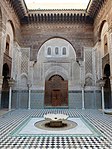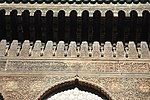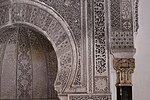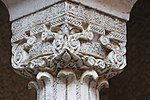Al-Attarine Madrasa
| Madrasa al-Attarine | |
|---|---|
مدرسة العطارين | |
 | |
 | |
| General information | |
| Type | madrasa |
| Architectural style | Moorish |
| Location | Fes,Morocco |
| Coordinates | 34°03′54.3″N4°58′25.3″W/ 34.065083°N 4.973694°W |
| Construction started | 1323CE |
| Completed | 1325CE |
| Technical details | |
| Material | cedar wood, brick,stucco,tile |
| Floor count | 2 |
TheAl-Attarine MadrasaorMedersa al-Attarine[1](Arabic:مدرسة العطارين,romanized:madrasat al-ʿattārīn,lit. 'school of the perfumers') is amadrasainFes,Morocco,near theAl-Qarawiyyin Mosque.It was built by theMarinidsultanUthman II Abu Said(r. 1310-1331) in 1323-5. The madrasa takes its name from theSouk al-Attarine,the spice and perfume market. It is considered one of the highest achievements of Marinid architecture due to its rich and harmonious decoration and its efficient use of limited space.[2][3][4][5]
History
[edit]
Context: Marinid madrasas
[edit]The Marinids were prolific builders ofmadrasas,a type of institution which originated in northeasternIranby the early 11th century and was progressively adopted further west.[4]These establishments served to trainIslamic scholars,particularly inIslamic lawand jurisprudence (fiqh). The madrasa in theSunniworld was generally antithetical to more "heterodox"religious doctrines, including the doctrine espoused by theAlmohad dynasty.As such, it only came to flourish in Morocco under the Marinid dynasty which succeeded the Almohads.[4]To the Marinids, madrasas played a part in bolstering the political legitimacy of their dynasty. They used this patronage to encourage the loyalty of Fes's influential but fiercely independent religious elites and also to portray themselves to the general population as protectors and promoters of orthodox Sunni Islam.[4][3]The madrasas also served to train the scholars and elites who operated their state's bureaucracy.[3]
The al-Attarine Madrasa, along with other nearby madrasas like theSaffarinand theMesbahiyya,was built in close proximity to the al-Qarawiyyin Mosque/University, the main center of learning in Fes and historically the most important intellectual center of Morocco.[6][7][8]The madrasas played a supporting role to the Qarawiyyin; unlike the mosque, they provided accommodations for students, particularly those coming from outside of Fes.[9]Many of these students were poor, seeking sufficient education to gain a higher position in their home towns, and the madrasas provided them with basic necessities such as lodging and bread.[8][7]However, the madrasas were also teaching institutions in their own right and offered their own courses, with someIslamic scholarsmaking their reputation by teaching at certain madrasas.[7]
Construction and operation of the madrasa
[edit]
The al-Attarine madrasa was built between 1323 and 1325 on the orders of the Marinid sultan Abu Sa'id Uthman II.[8][10][2]The supervisor of construction was Sheikh Beni Abu Muhammad Abdallah ibn Qasim al-Mizwar.[7][3]According to theRawd el-Qirtas(historical chronicle), the sultan personally observed the laying of the madrasa's foundations, in the company of localulema.[7]
The creation of the madrasa, as with all Islamic religious and charitable institutions of the time, required the endowment of ahabous,a charitable trust usually consisting ofmortmainproperties, which provided revenues to sustain the madrasa's operations and upkeep, set up on the sultan's directive.[7]This provided for the madrasa to host animam,muezzins,teachers, and accommodations for 50-60 students.[7][9][8]Most of the students at this particular madrasa were from towns and cities in northwestern Morocco such asTangier,Larache,andKsar el-Kebir.[9][8]
The madrasa has been classified as historic heritage monument in Morocco since 1915.[11]The madrasa has since been restored many times, but in a manner consistent with its original architectural style.[9]Today it is open as a historic site and tourist attraction.[12]
Architecture
[edit]Layout
[edit]The madrasa is a two-story building accessed via an L-shapedbent entranceat the eastern end of Tala'a Kebira street.[2][4]The vestibule leads to the main courtyard of the building, entered via an archway with a wooden screen (mashrabiya).[13]The south and north sides of the courtyard are occupied by galleries with two square pillars and two smaller marble columns, which support three carved wood arches in the middle and two smallerstuccomuqarnasarches on the sides.[4][2]Above these galleries are the facades of the second floor marked by windows looking into the courtyard. This second floor, accessed via a staircase off the southern side of the entrance vestibule, is occupied by 30 rooms which served as sleeping quarters for the students.[13][4]This makes for an overall arrangement similar to the slightly earlierMadrasa as-Sahrij.[4]The entrance vestibule also grants access to amida'a(ablutions hall) which is located at its northern side.[4][2]
At the courtyard's eastern end is another decorated archway which grants entrance to the prayer hall. Most of the Marinid-era madrasas were oriented so that the main axis of the building was already aligned with theqibla(the direction of prayer), allowing themihrab(niche symbolizing the qibla) of the prayer hall to be allowed with the entrance of the main courtyard.[4]However, the space into which the al-Attarine Madrasa was built evidently did not allow for this layout, and instead the mihrab is off to the side on the southern wall of the prayer hall, on an axis perpendicular to the main axis of the building.[4]The prayer hall itself is rectangular, but a triple-arched gallery on its north side allowed architects to place a square wooden cupola over the main space in front of the mihrab.[4]This unusual but elegant solution to the limited and awkward space available for construction demonstrates the ingenuity and rational approach to design that Marinid architects had achieved by this time.[2]: 313 [3]
-
Wooden roof andstucco decorationover the street in front of the madrasa's entrance
-
Woodenmashrabiyascreen at the entrance of the courtyard
-
Western side of the courtyard, looking towards the entrance
-
One of the galleries along the sides of the courtyard
-
Eastern side of the courtyard, looking towards the entrance of the prayer hall
-
The prayer hall andmihrab
-
The formerablutionsfacility (mida'a)
-
The upper floors of the madrasa, where the student sleeping quarters are located
Decoration
[edit]Although its exterior is completely plain (like most traditional Moroccan buildings of its kind), the madrasa is famous for its extensive and sophisticated interior decoration, which exhibits a rigorous balance between different elements, marking the period of highest achievement in Marinid architecture.[4][3][2]: 347, 360 The main courtyard demonstrates this in particular. The floor pavement and the lower walls and pillars are covered inzellij(mosaictilework). While most of thezellijis arranged to formgeometric patternsand other motifs, its top layer, near eye-level, features a band of calligraphic inscriptions onsgraffito-style tiles running around the courtyard.[2][14]Above this, in general, is a zone of extensive and intricately-carvedstucco decoration,including another layer of calligraphic decoration, niches and arches sculpted withmuqarnas,and large surfaces covered in a diverse array of arabesques (floral and vegetal patterns) and other Moroccan motifs.[2][3][5]Lastly, the upper zones generally feature surfaces of carved cedar wood, culminating in richly sculpted woodeneavesprojecting over the top of the walls. Wooden artwork is also present in the pyramidal woodencupolaceiling of the prayer hall, carved with geometric star patterns (similar to that found more broadly inMoorish architecture). The wood-carving on display here is also considered an example of the high point of Marinid artwork.[4]: 337
The prayer hall also features extensive stucco decoration, especially around the richly-decorated mihrab niche.[13][4]The entrance of the hall consists of a"lambrequin" -style archwhoseintradosare carved with muqarnas. The upper walls of the chamber, below the wooden cupola, also feature windows of coloured glass which are set intoleadgrilles (instead of the much more common stucco grilles of that period) forming intricate geometric or floral motifs.[13][4]: 338 Themarble(oronyx) columns and theengaged columnsof the courtyard and prayer hall also feature exceptionally elegant and richly-carvedcapitals,among the best examples of their kind in this period.[13][4]: 340
The madrasa also features notable examples of Marinid-era ornamentalmetalwork.The doors of the madrasa's entrance are made of cedar wood but are covered in decorativebronzeplating. The current doors in place today are replicas of the originals which are now kept at theDar Batha Museum.[3]The plating is composed of many pieces assembled together to form an interlacing geometric pattern similar to that found in other medieval Moroccan art forms such asQur'anicor manuscript decoration.[3]Each piece is chiseled with a background of arabesque or vegetal motifs, as well as a smallKuficscript composition inside each of the octagonal stars in the wider geometric pattern. This design marks an evolution and refinement of the earlierAlmoravid-era bronze-plated decoration on the doors of the nearby Qarawiyyin Mosque.[3]Another piece of notable metalwork in the madrasa is the original bronzechandelierhanging in the prayer hall, which includes an inscription praising the madrasa's founder.[3][13]
-
Example ofzellijtilework in the madrasa, with complex geometric patterns on the lower walls and a band ofcalligraphyabove
-
View of the small arches andblind arches(or niches) at the corners of the courtyard which are sculpted withmuqarnas
-
Example of motifs in carved stucco around the courtyard
-
Details of the wood-carving along the top of the walls in the courtyard
-
Wooden cupola ceiling in the prayer hall
-
The "lambrequin" ormuqarnasarch of the prayer hall's entrance
-
Details of the stucco decoration (and a marbleengaged column) around themihrab
-
Stucco decoration and coloured glass windows in the upper walls of the prayer hall
-
The decorative bronze plating of the doors at the madrasa's entrance (replicas of the originals)
-
The Marinid-era bronze chandelier in the prayer hall
References
[edit]- ^"Madrasa al-'Attarin".Archnet.Retrieved2020-04-16.
- ^abcdefghiKubisch, Natascha (2011). "Maghreb - Architecture". In Hattstein, Markus; Delius, Peter (eds.).Islam: Art and Architecture.h.f.ullmann. pp. 312–313.
- ^abcdefghijkLintz, Yannick; Déléry, Claire; Tuil Leonetti, Bulle (2014).Maroc médiéval: Un empire de l'Afrique à l'Espagne.Paris: Louvre éditions. p. 486.ISBN9782350314907.
- ^abcdefghijklmnopqMarçais, Georges (1954).L'architecture musulmane d'Occident.Paris: Arts et métiers graphiques. pp. 288–289.
- ^abBloom, Jonathan M. (2020).Architecture of the Islamic West: North Africa and the Iberian Peninsula, 700-1800.Yale University Press. p. 191.
- ^Métalsi, Mohamed (2003).Fès: La ville essentielle.Paris: ACR Édition Internationale.ISBN978-2867701528.
- ^abcdefgGaudio, Attilio (1982).Fès: Joyau de la civilisation islamique.Paris: Les Presse de l'UNESCO: Nouvelles Éditions Latines.ISBN2723301591.
- ^abcdeLe Tourneau, Roger (1949).Fès avant le protectorat: étude économique et sociale d'une ville de l'occident musulman.Casablanca: Société Marocaine de Librairie et d'Édition.
- ^abcdParker, Richard (1981).A practical guide to Islamic Monuments in Morocco.Charlottesville, VA: The Baraka Press.
- ^Lintz, Yannick; Déléry, Claire; Tuil Leonetti, Bulle (2014).Maroc médiéval: Un empire de l'Afrique à l'Espagne.Paris: Louvre éditions. p. 486.ISBN9782350314907.
- ^"Medersa El-Attarine".Inventaire et Documentation du Patrimoine Culturel du Maroc(in French).Retrieved2021-01-08.
- ^"Medersa El Attarine | Fez, Morocco Attractions".Lonely Planet.Retrieved2020-04-16.
- ^abcdefTouri, Abdelaziz; Benaboud, Mhammad; Boujibar El-Khatib, Naïma; Lakhdar, Kamal; Mezzine, Mohamed (2010).Le Maroc andalou: à la découverte d'un art de vivre(2 ed.). Ministère des Affaires Culturelles du Royaume du Maroc & Museum With No Frontiers.ISBN978-3902782311.
- ^Degeorge, Gérard; Porter, Yves (2001).The Art of the Islamic Tile.Translated by Radzinowicz, David. Flammarion. pp. 66–68.ISBN208010876X.
External links
[edit]- 'Attarin MadrasaatMuseum with no Frontiers
- Attarine Madrasa فاس - مدرسة العطارين- Photos from the Manar al-Athar Digital Photo archive




















